Exhibit 99.4
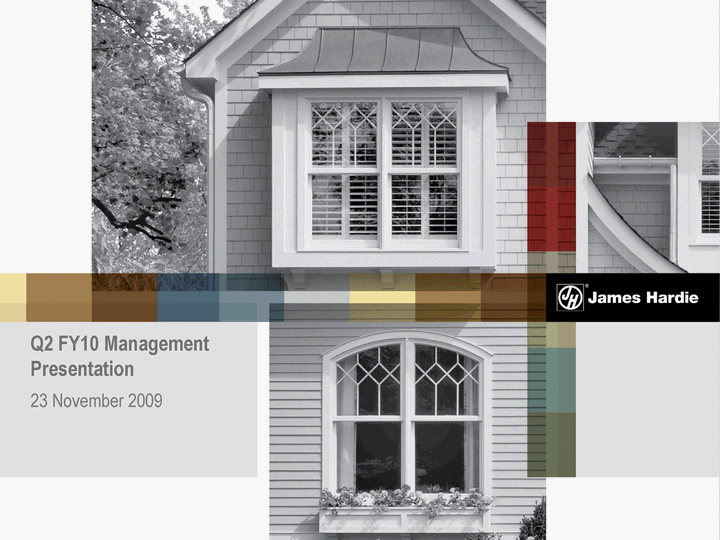
| Q2 FY10 Management Presentation 23 November 2009 |

| Q2 FY10 Management Presentation 23 November 2009 |

| Disclaimer This Management Presentation contains forward-looking statements. We may from time to time make forward-looking statements in our periodic reports filed with or furnished to the United States Securities and Exchange Commission on Forms 20-F and 6-K, in our annual reports to shareholders, in offering circulars, invitation memoranda and prospectuses, in media releases and other written materials and in oral statements made by our officers, directors or employees to analysts, institutional investors, existing and potential lenders, representatives of the media and others. Statements that are not historical facts are forward-looking statements and such forward- looking statements are statements made pursuant to the Safe Harbor Provisions of the Private Securities Litigation Reform Act of 1995. Examples of forward-looking statements include: statements about our future performance; projections of our results of operations or financial condition; statements regarding our plans, objectives or goals, including those relating to our strategies, initiatives, competition, acquisitions, dispositions and/or our products; expectations concerning the costs associated with the suspension or closure of operations at any of our plants and future plans with respect to any such plants; expectations that our credit facilities will be extended or renewed; expectations concerning dividend payments; statements concerning our corporate and tax domiciles and potential changes to them; statements regarding tax liabilities and related audits and proceedings; statements as to the possible consequences of proceedings brought against us and certain of our former directors and officers by the Australian Securities & Investments Commission; expectations about the timing and amount of contributions to the Asbestos Injuries Compensation Fund, a special purpose fund for the compensation of proven Australian asbestos-related personal injury and death claims; expectations concerning indemnification obligations; and statements about product or environmental liabilities. Words such as "believe," "anticipate," "plan," "expect," "intend," "target," "estimate," "project," "predict," "forecast," "guideline," "aim," "will," "should," "continue" and similar expressions are intended to identify forward-looking statements but are not the exclusive means of identifying such statements. Readers are cautioned not to place undue reliance on these forward-looking statements and all such forward-looking statements are qualified in their entirety by reference to the following cautionary statements. Forward-looking statements are based on our estimates and assumptions and because forward-looking statements address future results, events and conditions, they, by their very nature, involve inherent risks and uncertainties. Such known and unknown risks, uncertainties and other factors may cause our actual results, performance or other achievements to differ materially from the anticipated results, performance or achievements expressed, projected or implied by these forward-looking statements. These factors, some of which are discussed under "Key Information - Risk Factors" beginning on page 6 of the Form 20-F filed with the US Securities and Exchange Commission on 25 June 2009, include, but are not limited to: all matters relating to or arising out of the prior manufacture of products that contained asbestos by current and former James Hardie subsidiaries; required contributions to the AICF, any shortfall in the AICF and the effect of currency exchange rate movements on the amount recorded in our financial statements as an asbestos liability; compliance with and changes in tax laws and treatments; competition and product pricing in the markets in which we operate; the consequences of product failures or defects; exposure to environmental, asbestos or other legal proceedings; general economic and market conditions; the supply and cost of raw materials; the success of research and development efforts; reliance on a small number of customers; a customer's inability to pay; compliance with and changes in environmental and health and safety laws; risks of conducting business internationally; our pending transformation to a Dutch "SE" company and proposal to transfer our corporate domicile from The Netherlands to Ireland to become an Irish "SE" company; compliance with and changes in laws and regulations; currency exchange risks; the concentration of our customer base on large format retail customers, distributors and dealers; the effect of natural disasters; changes in our key management personnel; inherent limitations on internal controls; use of accounting estimates; and all other risks identified in our reports filed with Australian, Dutch and US securities agencies and exchanges (as appropriate). We caution you that the foregoing list of factors is not exhaustive and that other risks and uncertainties may cause actual results to differ materially from those in forward-looking statements. Forward-looking statements speak only as of the date they are made and are statements of our current expectations concerning future results, events and conditions. |
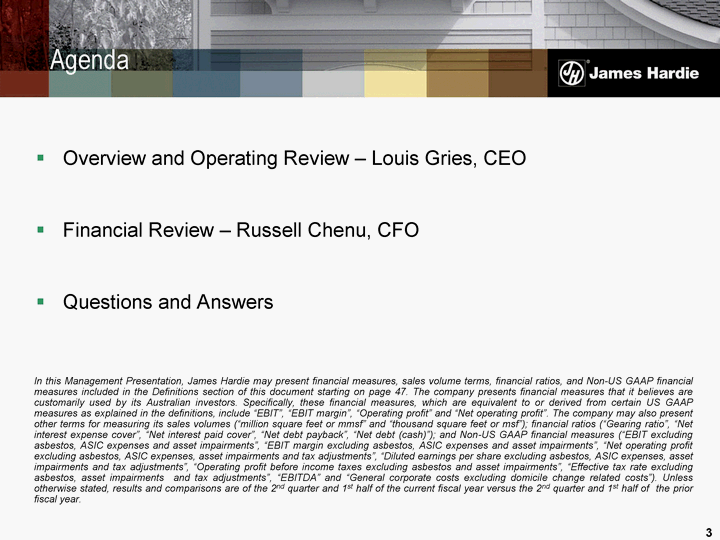
| Overview and Operating Review - Louis Gries, CEO Financial Review - Russell Chenu, CFO Questions and Answers Agenda In this Management Presentation, James Hardie may present financial measures, sales volume terms, financial ratios, and Non-US GAAP financial measures included in the Definitions section of this document starting on page 47. The company presents financial measures that it believes are customarily used by its Australian investors. Specifically, these financial measures, which are equivalent to or derived from certain US GAAP measures as explained in the definitions, include "EBIT", "EBIT margin", "Operating profit" and "Net operating profit". The company may also present other terms for measuring its sales volumes ("million square feet or mmsf" and "thousand square feet or msf"); financial ratios ("Gearing ratio", "Net interest expense cover", "Net interest paid cover", "Net debt payback", "Net debt (cash)"); and Non-US GAAP financial measures ("EBIT excluding asbestos, ASIC expenses and asset impairments", "EBIT margin excluding asbestos, ASIC expenses and asset impairments", "Net operating profit excluding asbestos, ASIC expenses, asset impairments and tax adjustments", "Diluted earnings per share excluding asbestos, ASIC expenses, asset impairments and tax adjustments", "Operating profit before income taxes excluding asbestos and asset impairments", "Effective tax rate excluding asbestos, asset impairments and tax adjustments", "EBITDA" and "General corporate costs excluding domicile change related costs"). Unless otherwise stated, results and comparisons are of the 2nd quarter and 1st half of the current fiscal year versus the 2nd quarter and 1st half of the prior fiscal year. |
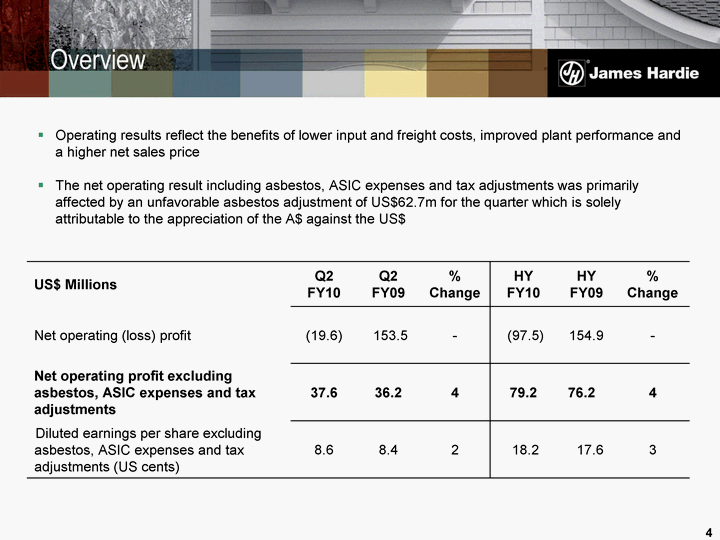
| Overview Operating results reflect the benefits of lower input and freight costs, improved plant performance and a higher net sales price The net operating result including asbestos, ASIC expenses and tax adjustments was primarily affected by an unfavorable asbestos adjustment of US$62.7m for the quarter which is solely attributable to the appreciation of the A$ against the US$ US$ Millions Q2 FY10 Q2 FY09 % Change HY FY10 HY FY09 % Change Net operating (loss) profit (19.6) 153.5 - (97.5) 154.9 - Net operating profit excluding asbestos, ASIC expenses and tax adjustments 37.6 36.2 4 79.2 76.2 4 Diluted earnings per share excluding asbestos, ASIC expenses and tax adjustments (US cents) 8.6 8.4 2 18.2 17.6 3 |

| Operating Review Louis Gries, CEO |

| Aggressively grow demand for our products in targeted market segments Grow our overall market position while defending our share in existing market segments Offer products with superior value to that of our competitors Introduce differentiated products to deliver a sustainable competitive advantage Global Strategy |
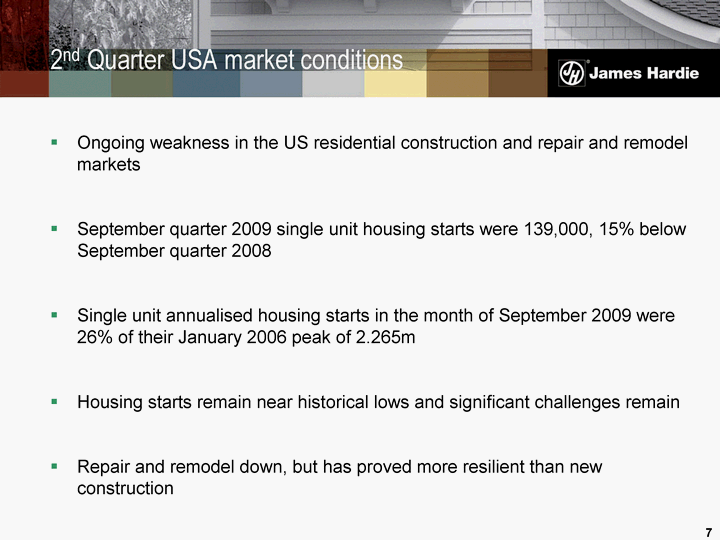
| Ongoing weakness in the US residential construction and repair and remodel markets September quarter 2009 single unit housing starts were 139,000, 15% below September quarter 2008 Single unit annualised housing starts in the month of September 2009 were 26% of their January 2006 peak of 2.265m Housing starts remain near historical lows and significant challenges remain Repair and remodel down, but has proved more resilient than new construction 2nd Quarter USA market conditions |
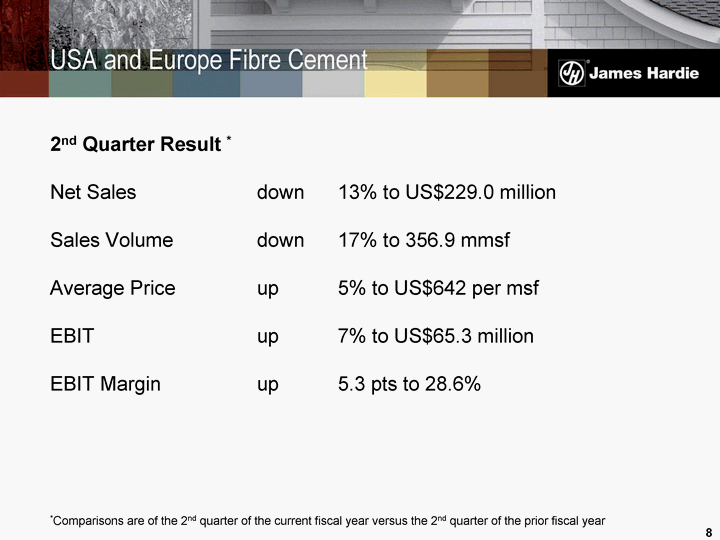
| 2nd Quarter Result * Net Sales down 13% to US$229.0 million Sales Volume down 17% to 356.9 mmsf Average Price up 5% to US$642 per msf EBIT up 7% to US$65.3 million EBIT Margin up 5.3 pts to 28.6% USA and Europe Fibre Cement *Comparisons are of the 2nd quarter of the current fiscal year versus the 2nd quarter of the prior fiscal year |
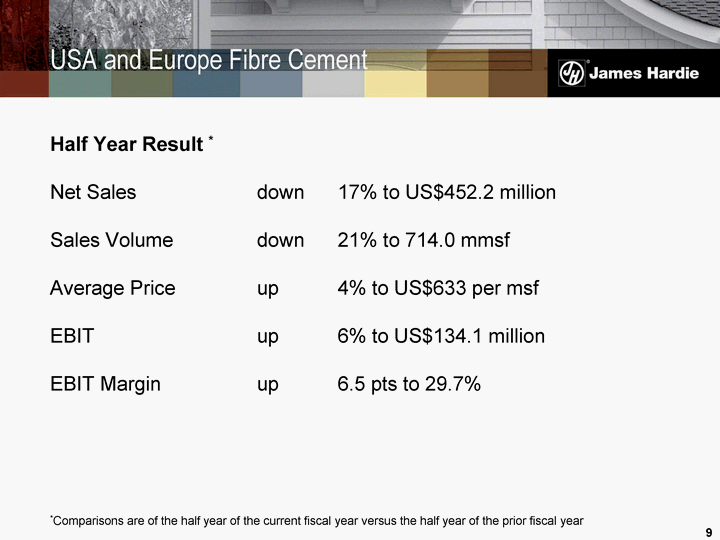
| Half Year Result * Net Sales down 17% to US$452.2 million Sales Volume down 21% to 714.0 mmsf Average Price up 4% to US$633 per msf EBIT up 6% to US$134.1 million EBIT Margin up 6.5 pts to 29.7% USA and Europe Fibre Cement *Comparisons are of the half year of the current fiscal year versus the half year of the prior fiscal year |
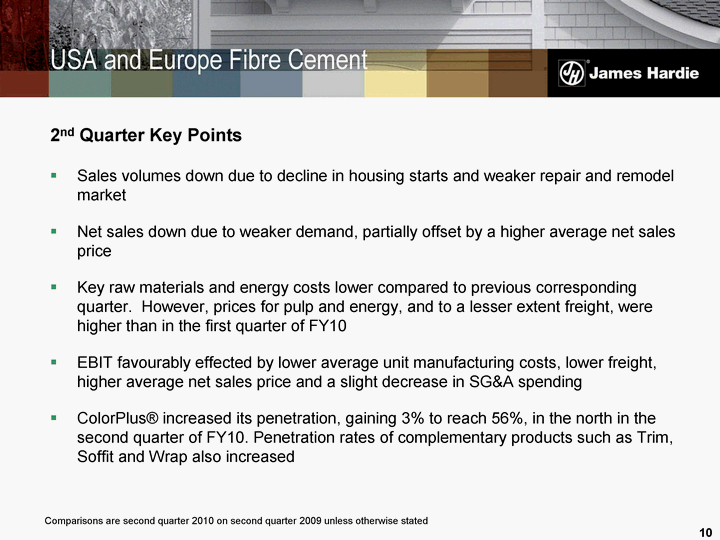
| USA and Europe Fibre Cement 2nd Quarter Key Points Sales volumes down due to decline in housing starts and weaker repair and remodel market Net sales down due to weaker demand, partially offset by a higher average net sales price Key raw materials and energy costs lower compared to previous corresponding quarter. However, prices for pulp and energy, and to a lesser extent freight, were higher than in the first quarter of FY10 EBIT favourably effected by lower average unit manufacturing costs, lower freight, higher average net sales price and a slight decrease in SG&A spending ColorPlus(r) increased its penetration, gaining 3% to reach 56%, in the north in the second quarter of FY10. Penetration rates of complementary products such as Trim, Soffit and Wrap also increased Comparisons are second quarter 2010 on second quarter 2009 unless otherwise stated |
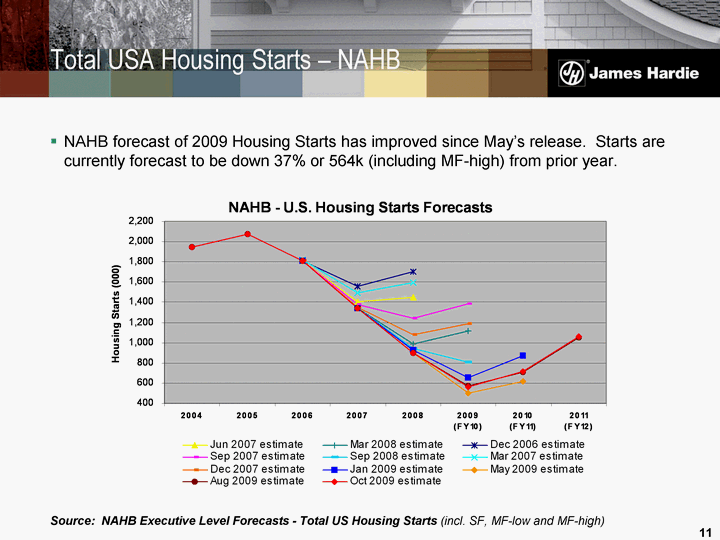
| Total USA Housing Starts - NAHB NAHB forecast of 2009 Housing Starts has improved since May's release. Starts are currently forecast to be down 37% or 564k (including MF-high) from prior year. Source: NAHB Executive Level Forecasts - Total US Housing Starts (incl. SF, MF-low and MF-high) |

| Outlook The US residential construction market continues to be volatile and it remains too early to ascertain the timing, rate or extent of any recovery Challenges remain including: restricted access to credit for prospective home owners expiration of the first home buyers' credit at the end of April 2010 continued deterioration of employment markets October 2009 decline in housing starts to six month low of 529,000* The business remains focused on: driving long term strategy sustaining earnings in a low demand environment and retaining the operational flexibility to lift production and achieve an increased rate of primary demand growth when a recovery eventuates We expect the US business will continue to perform solidly, allowing for seasonality, despite the challenging environment USA and Europe Fibre Cement *seasonally adjusted and annualised |

| USA Fibre Cement Rolling 12 month average of seasonally adjusted estimate of housing starts by US Census Bureau Jan-04 Jul-04 Jan-05 Jul-05 Jan-06 Jul-06 Jan-07 Jul-07 Jan-08 Jul-08 Jan-09 Jul-09 JH Volume (mmsf), Starts (000s Units) $0 $200 $400 $600 $800 $1,000 $1,200 Revenue (US$M) JH Volume JH Revenue Housing Starts |

| USA Fibre Cement Primary Growth Performance Sources: Dodge US addressable starts (SF & MF-low); US Census R&R $ expenditures less CPI Note: • US Census discontinued their R&R $ expenditures report in 2007 • 2008 R&R = avg. published Home Depot & Lowe's same store sales less CPI |
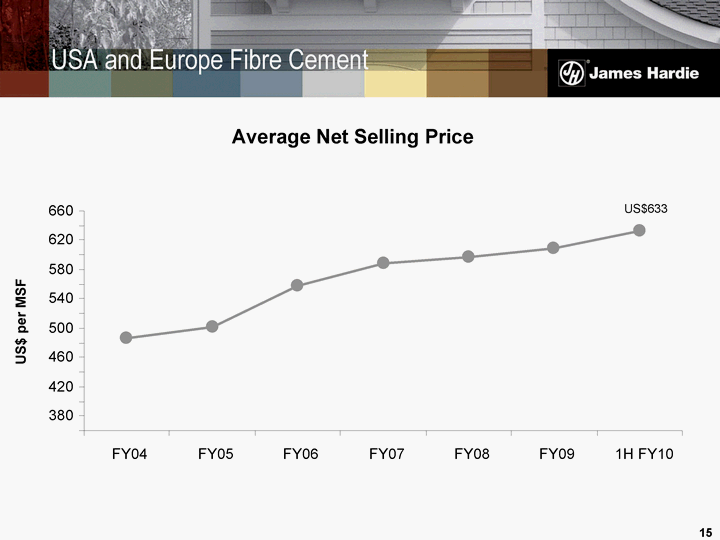
| Average Net Selling Price US$ per MSF USA and Europe Fibre Cement 380 420 460 500 540 580 620 660 FY04 FY05 FY06 FY07 FY08 FY09 1H FY10 US$633 |
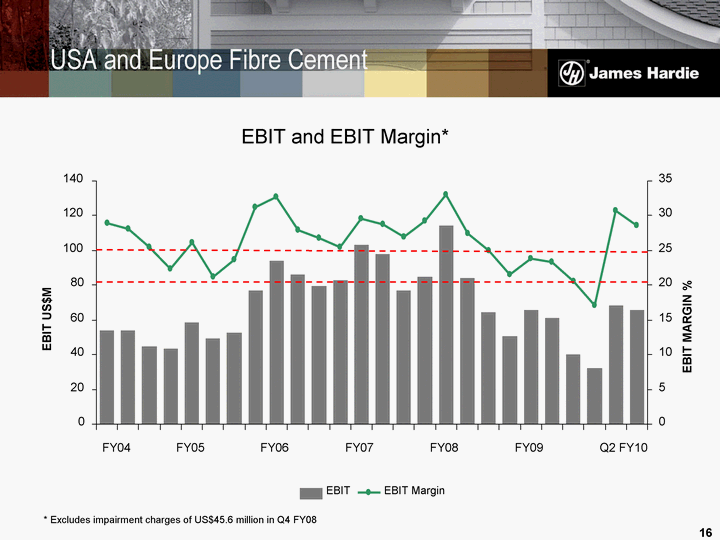
| USA and Europe Fibre Cement * Excludes impairment charges of US$45.6 million in Q4 FY08 EBIT and EBIT Margin* 0 20 40 60 80 100 120 140 FY04 FY05 FY06 FY07 FY08 FY09 Q2 FY10 EBIT US$M 0 5 10 15 20 25 30 35 EBIT MARGIN % EBIT EBIT Margin |
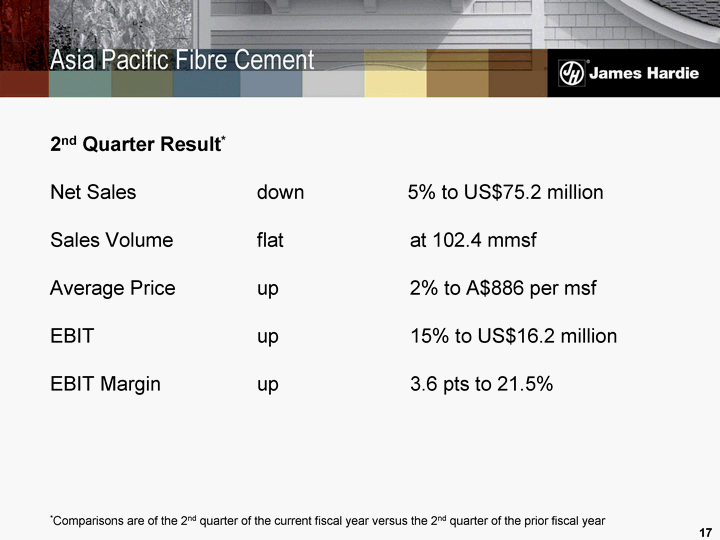
| 2nd Quarter Result* Net Sales down 5% to US$75.2 million Sales Volume flat at 102.4 mmsf Average Price up 2% to A$886 per msf EBIT up 15% to US$16.2 million EBIT Margin up 3.6 pts to 21.5% Asia Pacific Fibre Cement *Comparisons are of the 2nd quarter of the current fiscal year versus the 2nd quarter of the prior fiscal year |
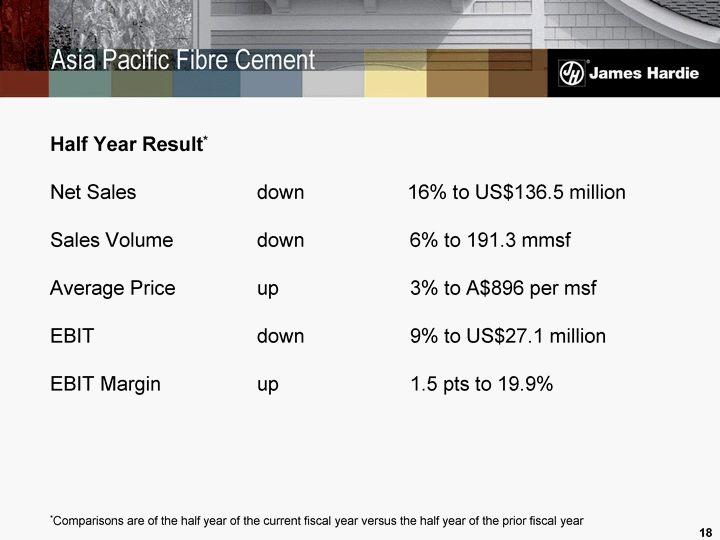
| Half Year Result* Net Sales down 16% to US$136.5 million Sales Volume down 6% to 191.3 mmsf Average Price up 3% to A$896 per msf EBIT down 9% to US$27.1 million EBIT Margin up 1.5 pts to 19.9% Asia Pacific Fibre Cement *Comparisons are of the half year of the current fiscal year versus the half year of the prior fiscal year |
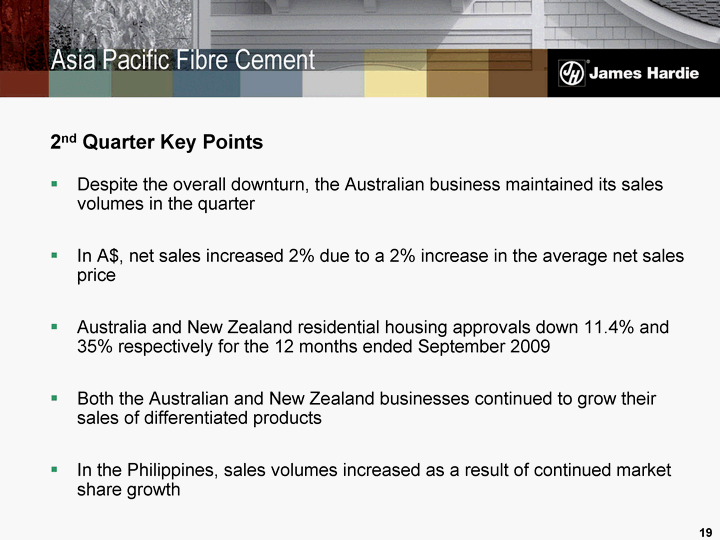
| 2nd Quarter Key Points Despite the overall downturn, the Australian business maintained its sales volumes in the quarter In A$, net sales increased 2% due to a 2% increase in the average net sales price Australia and New Zealand residential housing approvals down 11.4% and 35% respectively for the 12 months ended September 2009 Both the Australian and New Zealand businesses continued to grow their sales of differentiated products In the Philippines, sales volumes increased as a result of continued market share growth Asia Pacific Fibre Cement |
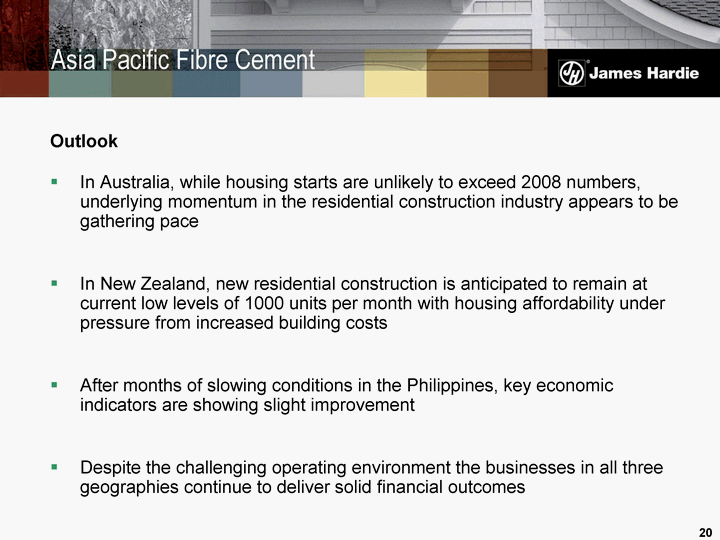
| Outlook In Australia, while housing starts are unlikely to exceed 2008 numbers, underlying momentum in the residential construction industry appears to be gathering pace In New Zealand, new residential construction is anticipated to remain at current low levels of 1000 units per month with housing affordability under pressure from increased building costs After months of slowing conditions in the Philippines, key economic indicators are showing slight improvement Despite the challenging operating environment the businesses in all three geographies continue to deliver solid financial outcomes Asia Pacific Fibre Cement |
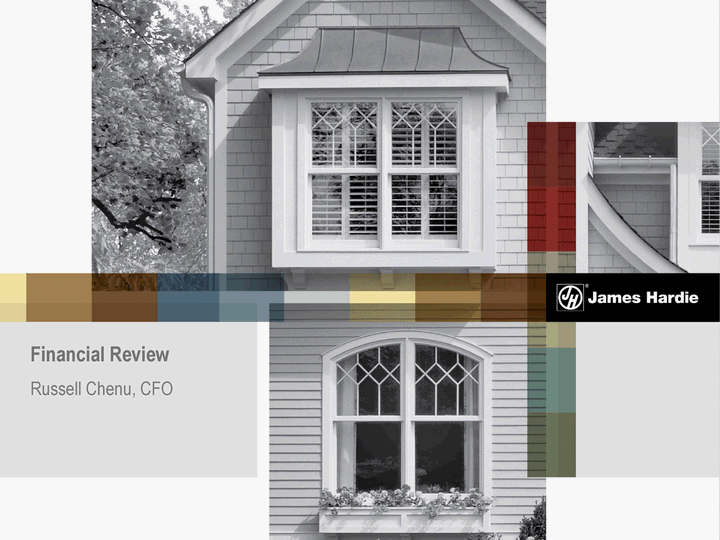
| Financial Review Russell Chenu, CFO |

| Overview Results continue to be affected by weak housing construction activity in all markets Net operating profit materially and adversely affected by asbestos Strong cash flow enabled an US$62.1 million reduction in net debt during the second quarter Decreases in SG&A spending compared to FY09 Significant depreciation of A$ : US$ exchange rate affecting results - each US$0.01 movement in A$ impacts earnings by approximately US$10m |
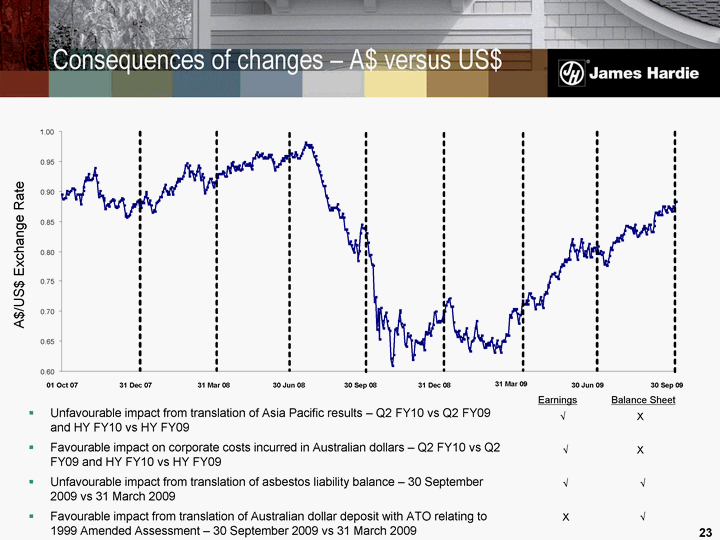
| Consequences of changes - A$ versus US$ Unfavourable impact from translation of Asia Pacific results - Q2 FY10 vs Q2 FY09 and HY FY10 vs HY FY09 Favourable impact on corporate costs incurred in Australian dollars - Q2 FY10 vs Q2 FY09 and HY FY10 vs HY FY09 Unfavourable impact from translation of asbestos liability balance - 30 September 2009 vs 31 March 2009 Favourable impact from translation of Australian dollar deposit with ATO relating to 1999 Amended Assessment - 30 September 2009 vs 31 March 2009 Earnings Balance Sheet ^ X ^ X ^ ^ X ^ 0.60 0.65 0.70 0.75 0.80 0.85 0.90 0.95 1.00 01 Oct 07 31 Dec 07 31 Mar 08 30 Jun 08 30 Sep 08 31 Dec 08 31 Mar 09 30 Jun 09 30 Sep 09 A$/US$ Exchange Rate |
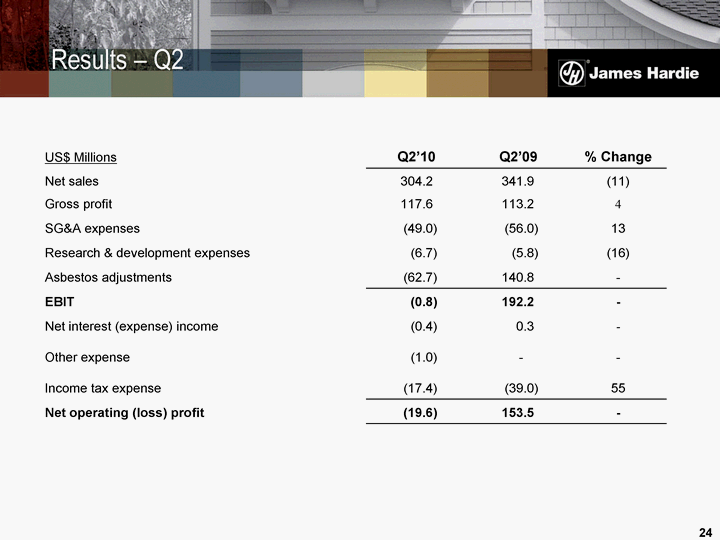
| Results - Q2 US$ Millions Q2'10 Q2'09 % Change Net sales 304.2 341.9 (11) Gross profit 117.6 113.2 4 SG&A expenses (49.0) (56.0) 13 Research & development expenses (6.7) (5.8) (16) Asbestos adjustments (62.7) 140.8 - EBIT (0.8) 192.2 - Net interest (expense) income (0.4) 0.3 - Other expense (1.0) - - Income tax expense (17.4) (39.0) 55 Net operating (loss) profit (19.6) 153.5 - |
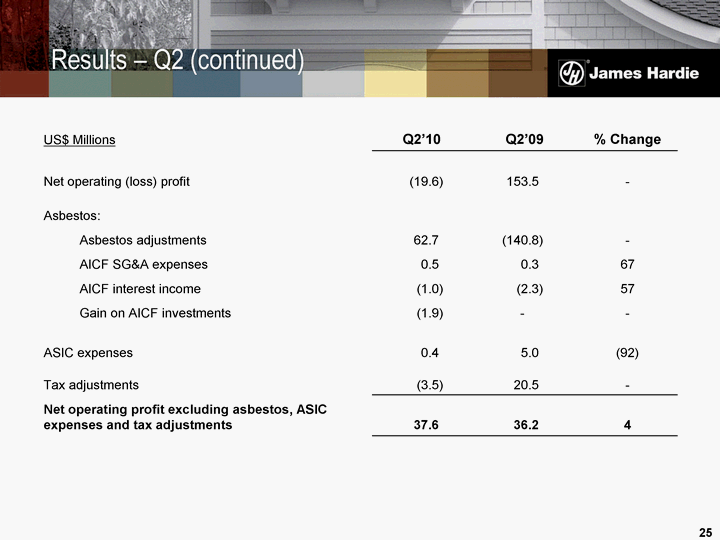
| Results - Q2 (continued) US$ Millions Q2'10 Q2'09 % Change Net operating (loss) profit (19.6) 153.5 - Asbestos: Asbestos adjustments 62.7 (140.8) - AICF SG&A expenses 0.5 0.3 67 AICF interest income (1.0) (2.3) 57 Gain on AICF investments (1.9) - - ASIC expenses 0.4 5.0 (92) Tax adjustments (3.5) 20.5 - Net operating profit excluding asbestos, ASIC expenses and tax adjustments 37.6 36.2 4 |

| Results - Half Year US$ Millions HY'10 HY'09 % Change Net sales 588.7 706.9 (17) Gross profit 228.0 237.2 (4) SG&A expenses (90.4) (110.2) 18 Research & development expenses (13.0) (12.2) (7) Asbestos adjustments (182.5) 100.3 - EBIT (57.9) 215.1 - Net interest expense (1.1) (0.8) (38) Other income 3.8 - - Income tax expense (42.3) (59.4) 29 Net operating (loss) profit (97.5) 154.9 - |
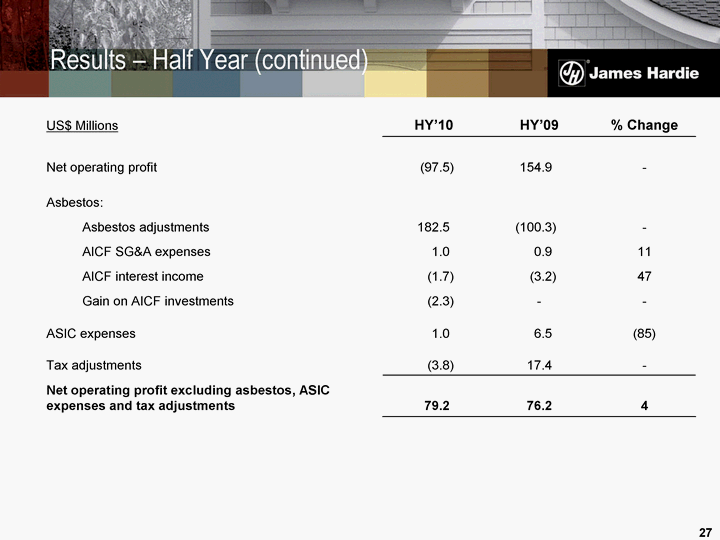
| Results - Half Year (continued) US$ Millions HY'10 HY'09 % Change Net operating profit (97.5) 154.9 - Asbestos: Asbestos adjustments 182.5 (100.3) - AICF SG&A expenses 1.0 0.9 11 AICF interest income (1.7) (3.2) 47 Gain on AICF investments (2.3) - - ASIC expenses 1.0 6.5 (85) Tax adjustments (3.8) 17.4 - Net operating profit excluding asbestos, ASIC expenses and tax adjustments 79.2 76.2 4 |
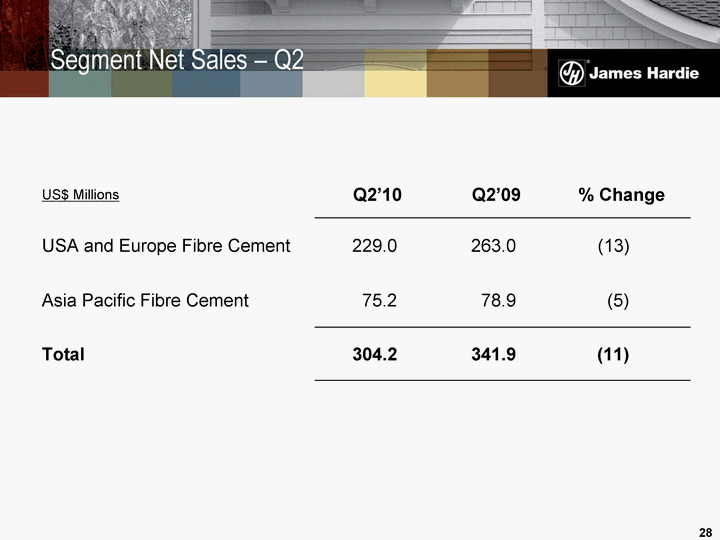
| US$ Millions Q2'10 Q2'09 % Change USA and Europe Fibre Cement 229.0 263.0 (13) Asia Pacific Fibre Cement 75.2 78.9 (5) Total 304.2 341.9 (11) Segment Net Sales - Q2 |

| US$ Millions HY'10 HY'09 % Change USA and Europe Fibre Cement 452.2 544.7 (17) Asia Pacific Fibre Cement 136.5 162.2 (16) Total 588.7 706.9 (17) Segment Net Sales - Half Year |

| US$ Millions Q2'10 Q2'09 % Change USA and Europe Fibre Cement 65.3 61.1 7 Asia Pacific Fibre Cement 16.2 14.1 15 Research & development1 (4.8) (5.0) 4 Total segment EBIT 76.7 70.2 9 General corporate excluding asbestos and ASIC expenses (13.9) (13.5) (3) Total EBIT excluding asbestos and ASIC expenses 62.8 56.7 11 Asbestos adjustments (62.7) 140.8 - AICF SG&A expenses (0.5) (0.3) (67) ASIC expenses (0.4) (5.0) 92 Total EBIT (0.8) 192.2 - 1 Research & development includes "core" research & development expenses and administrative expenses, but excludes product development expenses Segment EBIT - Q2 |
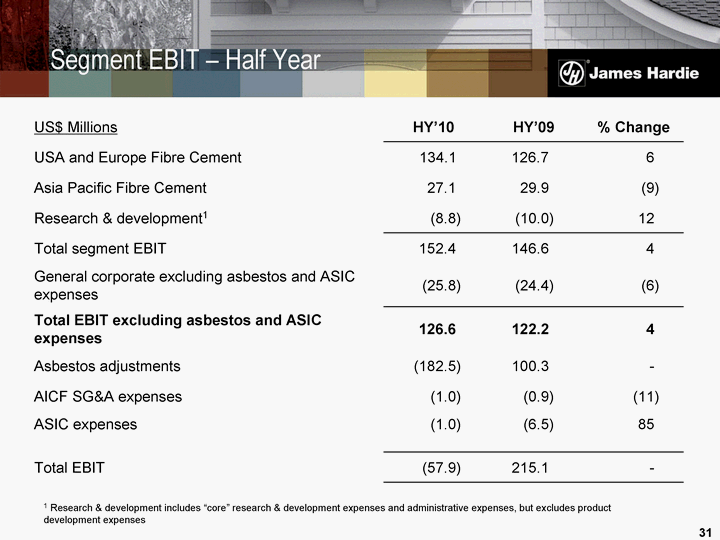
| US$ Millions HY'10 HY'09 % Change USA and Europe Fibre Cement 134.1 126.7 6 Asia Pacific Fibre Cement 27.1 29.9 (9) Research & development1 (8.8) (10.0) 12 Total segment EBIT 152.4 146.6 4 General corporate excluding asbestos and ASIC expenses (25.8) (24.4) (6) Total EBIT excluding asbestos and ASIC expenses 126.6 122.2 4 Asbestos adjustments (182.5) 100.3 - AICF SG&A expenses (1.0) (0.9) (11) ASIC expenses (1.0) (6.5) 85 Total EBIT (57.9) 215.1 - 1 Research & development includes "core" research & development expenses and administrative expenses, but excludes product development expenses Segment EBIT - Half Year |

| US$ Millions Q2'10 Q2'09 HY'10 HY'09 Gross interest expense (0.9) (2.3) (2.0) (4.9) Capitalised interest 0.1 - 0.1 - Interest income 0.1 0.3 0.2 0.9 Net interest expense excluding AICF interest income and interest rate swaps (0.7) (2.0) (1.7) (4.0) AICF interest income 1.0 2.3 1.7 3.2 Realised loss on interest rate swaps (0.7) - (1.1) - Net interest (expense) income (0.4) 0.3 (1.1) (0.8) Net Interest (Expense) Income |
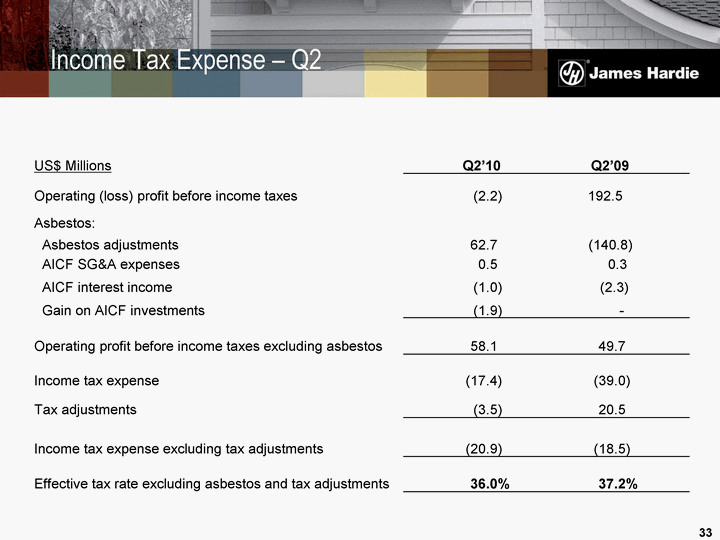
| Income Tax Expense - Q2 US$ Millions Q2'10 Q2'09 Operating (loss) profit before income taxes (2.2) 192.5 Asbestos: Asbestos adjustments 62.7 (140.8) AICF SG&A expenses 0.5 0.3 AICF interest income (1.0) (2.3) Gain on AICF investments (1.9) - Operating profit before income taxes excluding asbestos 58.1 49.7 Income tax expense (17.4) (39.0) Tax adjustments (3.5) 20.5 Income tax expense excluding tax adjustments (20.9) (18.5) Effective tax rate excluding asbestos and tax adjustments 36.0% 37.2% |
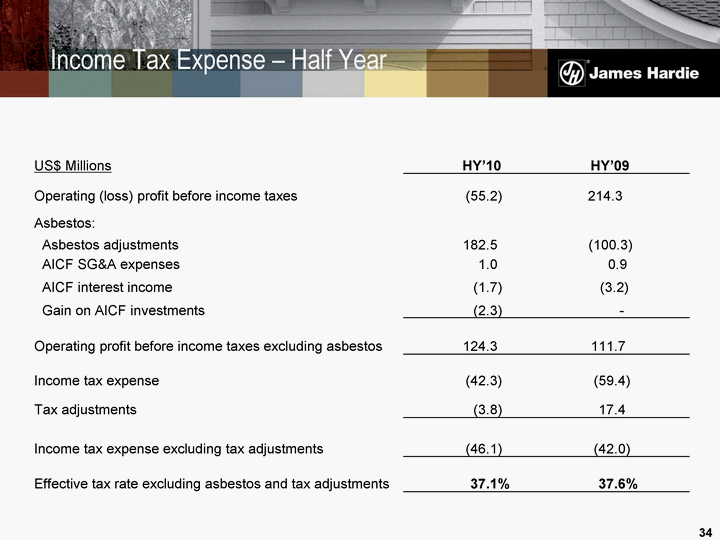
| Income Tax Expense - Half Year US$ Millions HY'10 HY'09 Operating (loss) profit before income taxes (55.2) 214.3 Asbestos: Asbestos adjustments 182.5 (100.3) AICF SG&A expenses 1.0 0.9 AICF interest income (1.7) (3.2) Gain on AICF investments (2.3) - Operating profit before income taxes excluding asbestos 124.3 111.7 Income tax expense (42.3) (59.4) Tax adjustments (3.8) 17.4 Income tax expense excluding tax adjustments (46.1) (42.0) Effective tax rate excluding asbestos and tax adjustments 37.1% 37.6% |
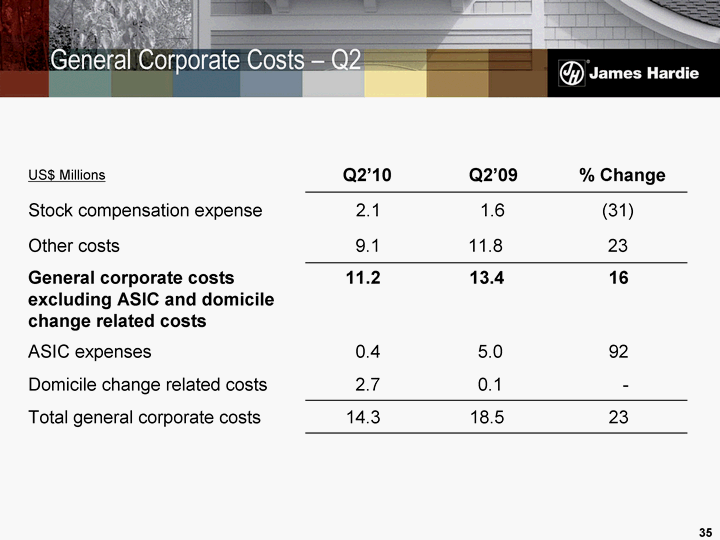
| US$ Millions Q2'10 Q2'09 % Change Stock compensation expense 2.1 1.6 (31) Other costs 9.1 11.8 23 General corporate costs excluding ASIC and domicile change related costs 11.2 13.4 16 ASIC expenses 0.4 5.0 92 Domicile change related costs 2.7 0.1 - Total general corporate costs 14.3 18.5 23 General Corporate Costs - Q2 |
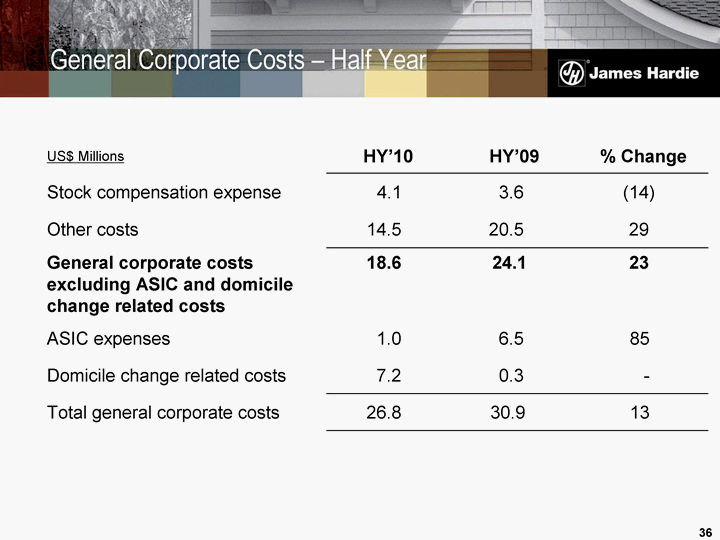
| US$ Millions HY'10 HY'09 % Change Stock compensation expense 4.1 3.6 (14) Other costs 14.5 20.5 29 General corporate costs excluding ASIC and domicile change related costs 18.6 24.1 23 ASIC expenses 1.0 6.5 85 Domicile change related costs 7.2 0.3 - Total general corporate costs 26.8 30.9 13 General Corporate Costs - Half Year |

| US$ Millions Q2'10 Q2'09 % Change EBIT USA and Europe Fibre Cement 65.3 61.1 7 Asia Pacific Fibre Cement 16.2 14.1 15 Research & development (4.8) (5.0) 2 General corporate excluding asbestos and ASIC expenses (13.9) (13.5) (3) Depreciation and Amortisation USA and Europe Fibre Cement 12.8 11.7 9 Asia Pacific Fibre Cement 2.0 2.9 (31) Total EBITDA excluding asbestos and ASIC expenses 77.6 71.3 9 Asbestos adjustments (62.7) 140.8 - AICF SG&A expenses (0.5) (0.3) (67) ASIC expenses (0.4) (5.0) 92 Total EBITDA 14.0 206.8 (93) EBITDA - Q2 |
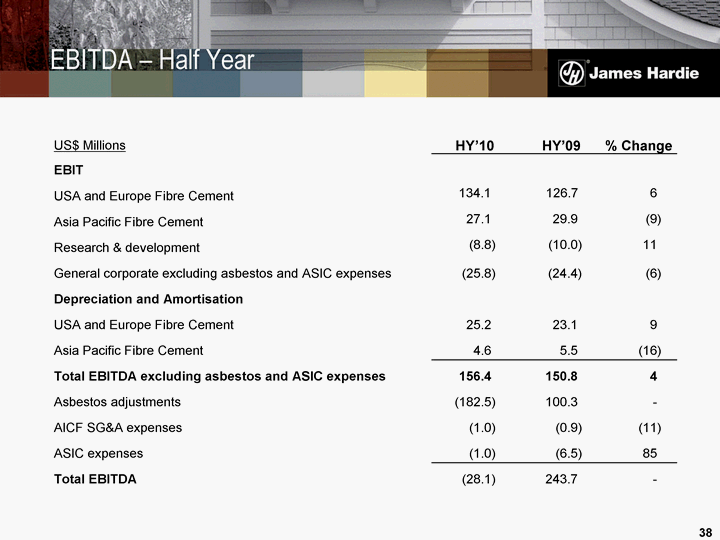
| US$ Millions HY'10 HY'09 % Change EBIT USA and Europe Fibre Cement 134.1 126.7 6 Asia Pacific Fibre Cement 27.1 29.9 (9) Research & development (8.8) (10.0) 11 General corporate excluding asbestos and ASIC expenses (25.8) (24.4) (6) Depreciation and Amortisation USA and Europe Fibre Cement 25.2 23.1 9 Asia Pacific Fibre Cement 4.6 5.5 (16) Total EBITDA excluding asbestos and ASIC expenses 156.4 150.8 4 Asbestos adjustments (182.5) 100.3 - AICF SG&A expenses (1.0) (0.9) (11) ASIC expenses (1.0) (6.5) 85 Total EBITDA (28.1) 243.7 - EBITDA - Half Year |
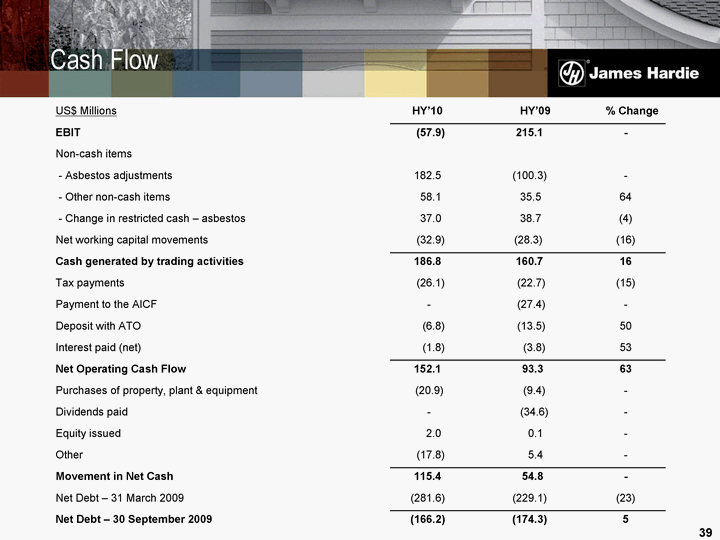
| Cash Flow US$ Millions HY'10 HY'09 % Change EBIT (57.9) 215.1 - Non-cash items - Asbestos adjustments 182.5 (100.3) - - Other non-cash items 58.1 35.5 64 - Change in restricted cash - asbestos 37.0 38.7 (4) Net working capital movements (32.9) (28.3) (16) Cash generated by trading activities 186.8 160.7 16 Tax payments (26.1) (22.7) (15) Payment to the AICF - (27.4) - Deposit with ATO (6.8) (13.5) 50 Interest paid (net) (1.8) (3.8) 53 Net Operating Cash Flow 152.1 93.3 63 Purchases of property, plant & equipment (20.9) (9.4) - Dividends paid - (34.6) - Equity issued 2.0 0.1 - Other (17.8) 5.4 - Movement in Net Cash 115.4 54.8 - Net Debt - 31 March 2009 (281.6) (229.1) (23) Net Debt - 30 September 2009 (166.2) (174.3) 5 |

| US$ Millions HY'10 HY'09 % Change USA and Europe Fibre Cement 17.5 6.9 (153) Asia Pacific Fibre Cement 3.4 2.5 (36) Total 20.9 9.4 (122) Capital Expenditure |
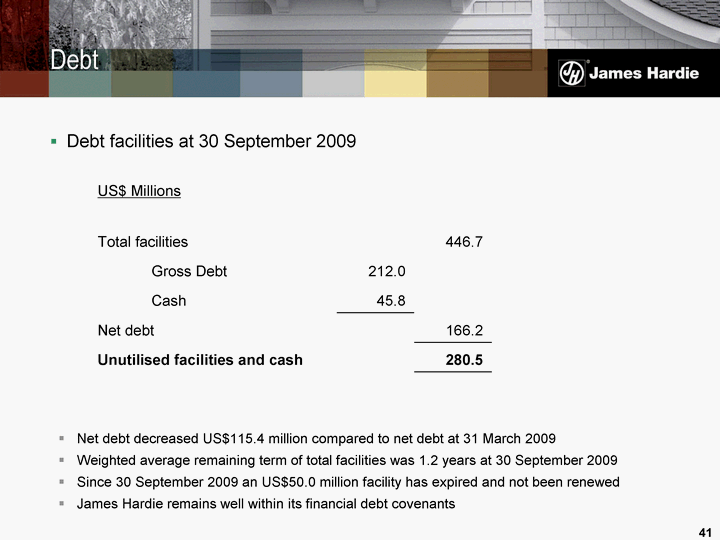
| Debt Net debt decreased US$115.4 million compared to net debt at 31 March 2009 Weighted average remaining term of total facilities was 1.2 years at 30 September 2009 Since 30 September 2009 an US$50.0 million facility has expired and not been renewed James Hardie remains well within its financial debt covenants US$ Millions Total facilities 446.7 Gross Debt 212.0 Cash 45.8 Net debt 166.2 Unutilised facilities and cash 280.5 Debt facilities at 30 September 2009 |
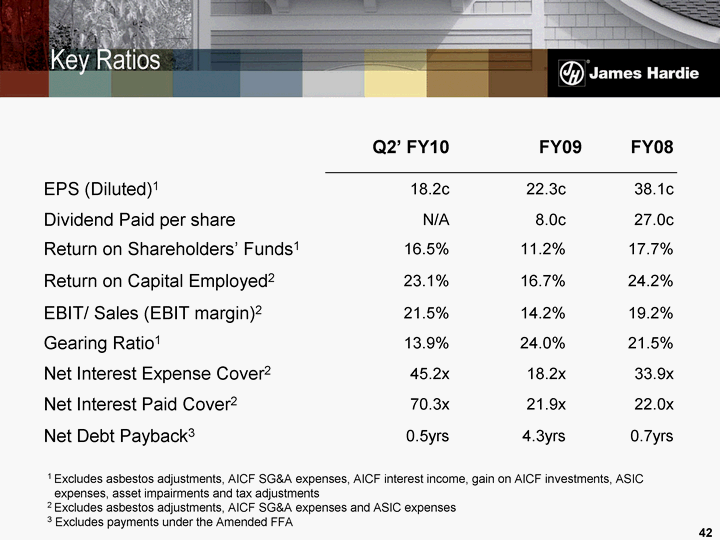
| Key Ratios Q2' FY10 FY09 FY09 FY08 EPS (Diluted)1 18.2c 18.2c 22.3c 38.1c 38.1c Dividend Paid per share N/A N/A 8.0c 27.0c 27.0c Return on Shareholders' Funds1 16.5% 16.5% 11.2% 17.7% 17.7% Return on Capital Employed2 23.1% 23.1% 16.7% 24.2% 24.2% EBIT/ Sales (EBIT margin)2 21.5% 21.5% 14.2% 19.2% 19.2% Gearing Ratio1 13.9% 13.9% 24.0% 21.5% 21.5% Net Interest Expense Cover2 45.2x 45.2x 18.2x 33.9x 33.9x Net Interest Paid Cover2 70.3x 70.3x 21.9x 22.0x 22.0x Net Debt Payback3 0.5yrs 0.5yrs 4.3yrs 0.7yrs 0.7yrs 1 Excludes asbestos adjustments, AICF SG&A expenses, AICF interest income, gain on AICF investments, ASIC expenses, asset impairments and tax adjustments 2 Excludes asbestos adjustments, AICF SG&A expenses and ASIC expenses 3 Excludes payments under the Amended FFA |
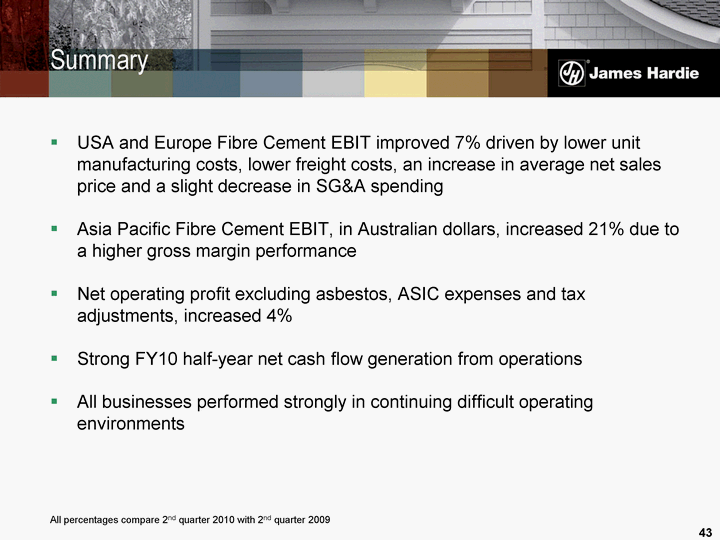
| USA and Europe Fibre Cement EBIT improved 7% driven by lower unit manufacturing costs, lower freight costs, an increase in average net sales price and a slight decrease in SG&A spending Asia Pacific Fibre Cement EBIT, in Australian dollars, increased 21% due to a higher gross margin performance Net operating profit excluding asbestos, ASIC expenses and tax adjustments, increased 4% Strong FY10 half-year net cash flow generation from operations All businesses performed strongly in continuing difficult operating environments Summary All percentages compare 2nd quarter 2010 with 2nd quarter 2009 |
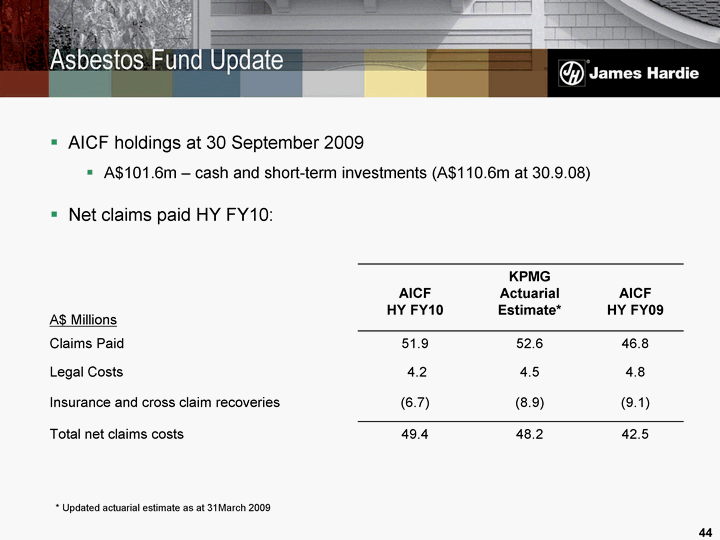
| AICF holdings at 30 September 2009 A$101.6m - cash and short-term investments (A$110.6m at 30.9.08) Net claims paid HY FY10: A$ Millions AICF HY FY10 KPMG Actuarial Estimate* AICF HY FY09 Claims Paid 51.9 52.6 46.8 Legal Costs 4.2 4.5 4.8 Insurance and cross claim recoveries (6.7) (8.9) (9.1) Total net claims costs 49.4 48.2 42.5 * Updated actuarial estimate as at 31March 2009 Asbestos Fund Update |

| Legacy Issues Update Asbestos On 7 November 2009, the Australian and NSW Governments announced a A$320m standby loan facility for Asbestos Injuries Compensation Fund (AICF) James Hardie reiterated its commitment to its obligations as agreed with AICF and the NSW Government in the Amended and Restated Final Funding Agreement ATO - 1999 Disputed Amended Assessment Federal Court hearings completed in September 2009 Judgement expected late 2009/early 2010 ATO deposit as at September 2009 was US$229.3m ASIC Proceedings All defendants other than Peter Macdonald and ABN60 have appealed the Supreme Court decision Appeal hearing set down to commence on 19 April 2010 Domicile Stage one of the two stage proposal to move domicile to Ireland approved by 99.3% of votes cast on 21 August 2009 An EGM to seek shareholder approval for stage two of the proposal to become an Irish SE is expected for early 2010 |
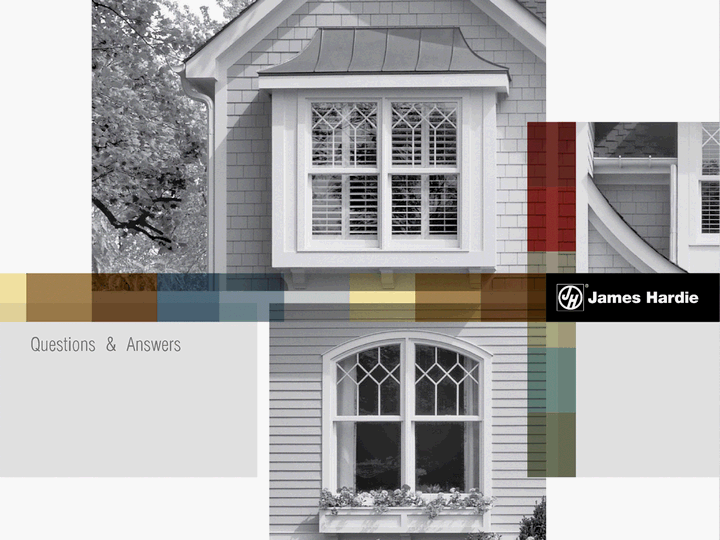
| Questions & Answers |
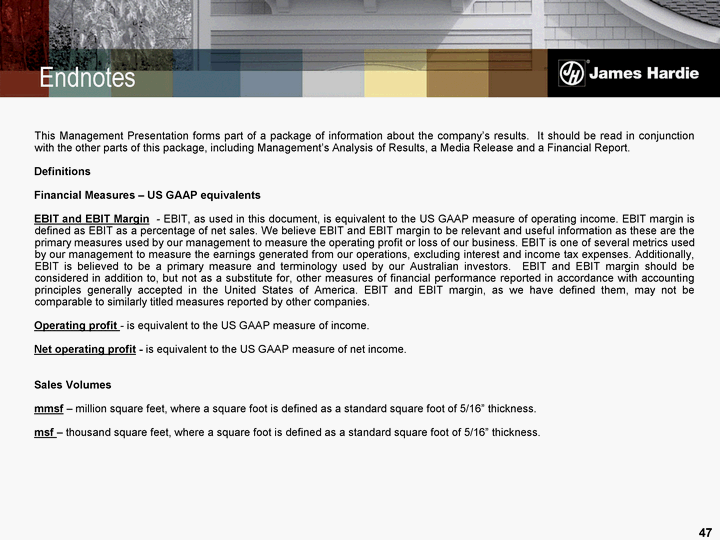
| Endnotes This Management Presentation forms part of a package of information about the company's results. It should be read in conjunction with the other parts of this package, including Management's Analysis of Results, a Media Release and a Financial Report. Definitions Financial Measures - US GAAP equivalents EBIT and EBIT Margin - EBIT, as used in this document, is equivalent to the US GAAP measure of operating income. EBIT margin is defined as EBIT as a percentage of net sales. We believe EBIT and EBIT margin to be relevant and useful information as these are the primary measures used by our management to measure the operating profit or loss of our business. EBIT is one of several metrics used by our management to measure the earnings generated from our operations, excluding interest and income tax expenses. Additionally, EBIT is believed to be a primary measure and terminology used by our Australian investors. EBIT and EBIT margin should be considered in addition to, but not as a substitute for, other measures of financial performance reported in accordance with accounting principles generally accepted in the United States of America. EBIT and EBIT margin, as we have defined them, may not be comparable to similarly titled measures reported by other companies. Operating profit - is equivalent to the US GAAP measure of income. Net operating profit - is equivalent to the US GAAP measure of net income. Sales Volumes mmsf - million square feet, where a square foot is defined as a standard square foot of 5/16" thickness. msf - thousand square feet, where a square foot is defined as a standard square foot of 5/16" thickness. |
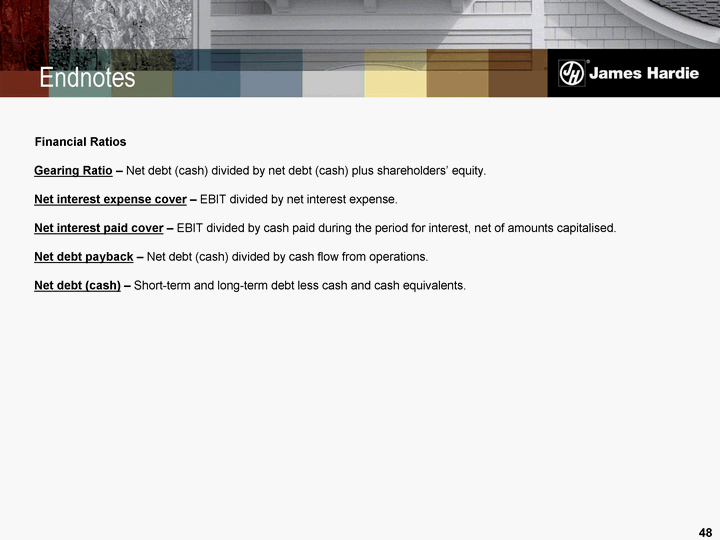
| Endnotes Financial Ratios Gearing Ratio - Net debt (cash) divided by net debt (cash) plus shareholders' equity. Net interest expense cover - EBIT divided by net interest expense. Net interest paid cover - EBIT divided by cash paid during the period for interest, net of amounts capitalised. Net debt payback - Net debt (cash) divided by cash flow from operations. Net debt (cash) - Short-term and long-term debt less cash and cash equivalents. |
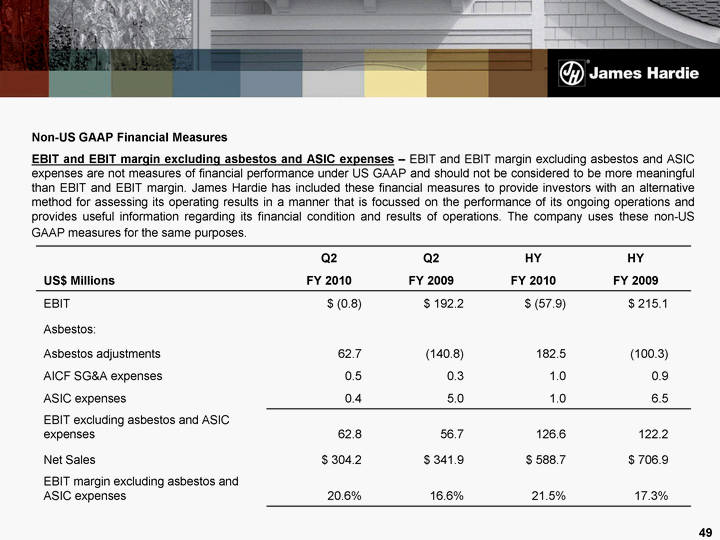
| Non-US GAAP Financial Measures EBIT and EBIT margin excluding asbestos and ASIC expenses - EBIT and EBIT margin excluding asbestos and ASIC expenses are not measures of financial performance under US GAAP and should not be considered to be more meaningful than EBIT and EBIT margin. James Hardie has included these financial measures to provide investors with an alternative method for assessing its operating results in a manner that is focussed on the performance of its ongoing operations and provides useful information regarding its financial condition and results of operations. The company uses these non-US GAAP measures for the same purposes. Q2 Q2 HY HY US$ Millions FY 2010 FY 2009 FY 2010 FY 2009 EBIT $ (0.8) $ 192.2 $ (57.9) $ 215.1 Asbestos: Asbestos adjustments 62.7 (140.8) 182.5 (100.3) AICF SG&A expenses 0.5 0.3 1.0 0.9 ASIC expenses 0.4 5.0 1.0 6.5 EBIT excluding asbestos and ASIC expenses 62.8 56.7 126.6 122.2 Net Sales $ 304.2 $ 341.9 $ 588.7 $ 706.9 EBIT margin excluding asbestos and ASIC expenses 20.6% 16.6% 21.5% 17.3% |
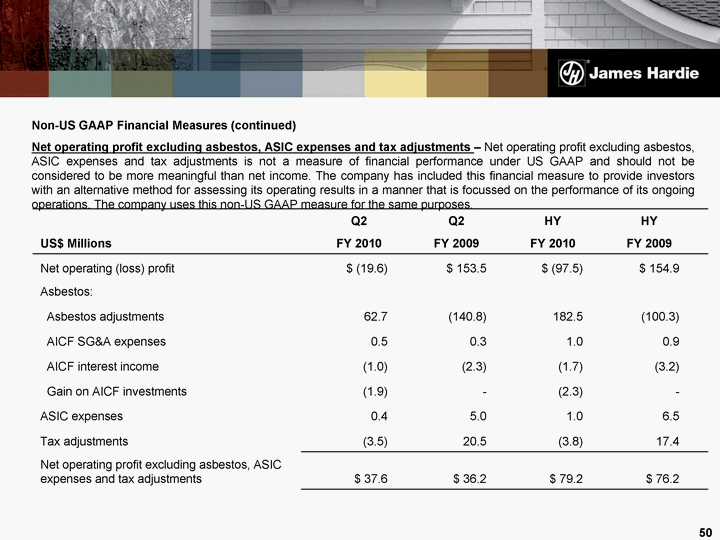
| Non-US GAAP Financial Measures (continued) Net operating profit excluding asbestos, ASIC expenses and tax adjustments - Net operating profit excluding asbestos, ASIC expenses and tax adjustments is not a measure of financial performance under US GAAP and should not be considered to be more meaningful than net income. The company has included this financial measure to provide investors with an alternative method for assessing its operating results in a manner that is focussed on the performance of its ongoing operations. The company uses this non-US GAAP measure for the same purposes. Q2 Q2 HY HY US$ Millions FY 2010 FY 2009 FY 2010 FY 2009 Net operating (loss) profit $ (19.6) $ 153.5 $ (97.5) $ 154.9 Asbestos: Asbestos adjustments 62.7 (140.8) 182.5 (100.3) AICF SG&A expenses 0.5 0.3 1.0 0.9 AICF interest income (1.0) (2.3) (1.7) (3.2) Gain on AICF investments (1.9) - (2.3) - ASIC expenses 0.4 5.0 1.0 6.5 Tax adjustments (3.5) 20.5 (3.8) 17.4 Net operating profit excluding asbestos, ASIC expenses and tax adjustments $ 37.6 $ 36.2 $ 79.2 $ 76.2 |

| Non-US GAAP Financial Measures (continued) Diluted earnings per share excluding asbestos, ASIC expenses and tax adjustments - Diluted earnings per share excluding asbestos, ASIC expenses and tax adjustments is not a measure of financial performance under US GAAP and should not be considered to be more meaningful than diluted earnings per share. The company has included this financial measure to provide investors with an alternative method for assessing its operating results in a manner that is focussed on the performance of its ongoing operations. The company's management uses this non-US GAAP measure for the same purposes. Q2 Q2 HY HY US$ Millions FY 2010 FY 2009 FY 2010 FY 2009 Net operating profit excluding asbestos, ASIC expenses and tax adjustments $ 37.6 $ 36.2 $ 79.2 $ 76.2 Weighted average common shares outstanding - Diluted (millions) 436.4 433.0 436.0 433.1 Diluted earnings per share excluding asbestos, ASIC expenses and tax adjustments (US cents) 8.6 8.4 18.2 17.6 |
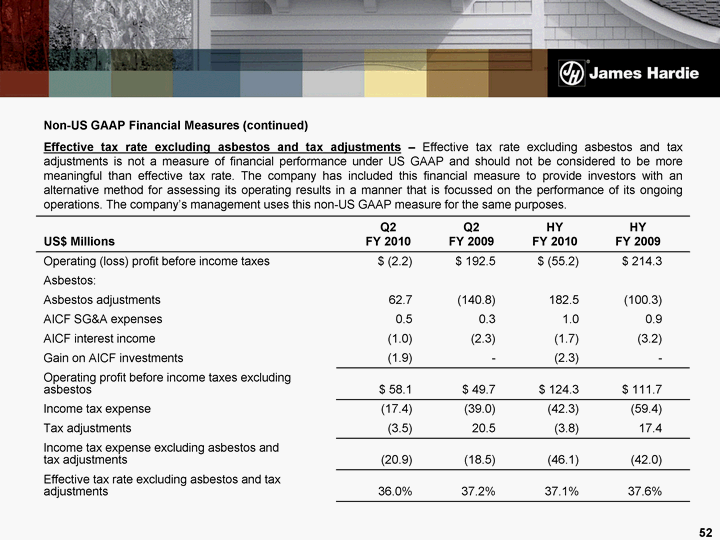
| Non-US GAAP Financial Measures (continued) Effective tax rate excluding asbestos and tax adjustments - Effective tax rate excluding asbestos and tax adjustments is not a measure of financial performance under US GAAP and should not be considered to be more meaningful than effective tax rate. The company has included this financial measure to provide investors with an alternative method for assessing its operating results in a manner that is focussed on the performance of its ongoing operations. The company's management uses this non-US GAAP measure for the same purposes. US$ Millions Q2 FY 2010 Q2 FY 2009 HY FY 2010 HY FY 2009 Operating (loss) profit before income taxes $ (2.2) $ 192.5 $ (55.2) $ 214.3 Asbestos: Asbestos adjustments 62.7 (140.8) 182.5 (100.3) AICF SG&A expenses 0.5 0.3 1.0 0.9 AICF interest income (1.0) (2.3) (1.7) (3.2) Gain on AICF investments (1.9) - (2.3) - Operating profit before income taxes excluding asbestos $ 58.1 $ 49.7 $ 124.3 $ 111.7 Income tax expense (17.4) (39.0) (42.3) (59.4) Tax adjustments (3.5) 20.5 (3.8) 17.4 Income tax expense excluding asbestos and tax adjustments (20.9) (18.5) (46.1) (42.0) Effective tax rate excluding asbestos and tax adjustments 36.0% 37.2% 37.1% 37.6% |
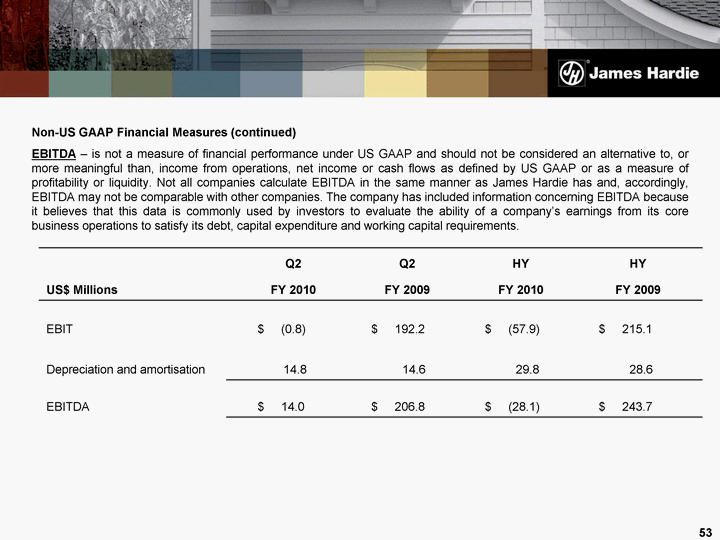
| Non-US GAAP Financial Measures (continued) EBITDA - is not a measure of financial performance under US GAAP and should not be considered an alternative to, or more meaningful than, income from operations, net income or cash flows as defined by US GAAP or as a measure of profitability or liquidity. Not all companies calculate EBITDA in the same manner as James Hardie has and, accordingly, EBITDA may not be comparable with other companies. The company has included information concerning EBITDA because it believes that this data is commonly used by investors to evaluate the ability of a company's earnings from its core business operations to satisfy its debt, capital expenditure and working capital requirements. Q2 Q2 HY HY US$ Millions FY 2010 FY 2009 FY 2010 FY 2009 EBIT $ (0.8) $ 192.2 $ (57.9) $ 215.1 Depreciation and amortisation 14.8 14.6 29.8 28.6 EBITDA $ 14.0 $ 206.8 $ (28.1) $ 243.7 |
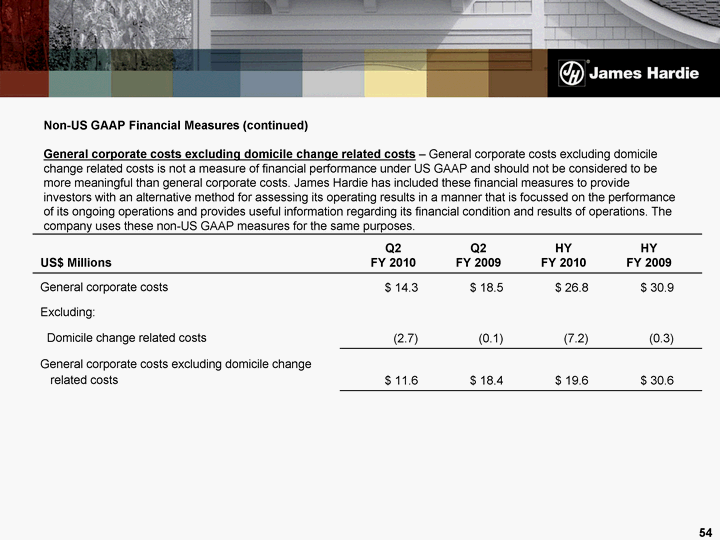
| Non-US GAAP Financial Measures (continued) General corporate costs excluding domicile change related costs - General corporate costs excluding domicile change related costs is not a measure of financial performance under US GAAP and should not be considered to be more meaningful than general corporate costs. James Hardie has included these financial measures to provide investors with an alternative method for assessing its operating results in a manner that is focussed on the performance of its ongoing operations and provides useful information regarding its financial condition and results of operations. The company uses these non-US GAAP measures for the same purposes. US$ Millions Q2 FY 2010 Q2 FY 2009 HY FY 2010 HY FY 2009 General corporate costs $ 14.3 $ 18.5 $ 26.8 $ 30.9 Excluding: Domicile change related costs (2.7) (0.1) (7.2) (0.3) General corporate costs excluding domicile change related costs $ 11.6 $ 18.4 $ 19.6 $ 30.6 |
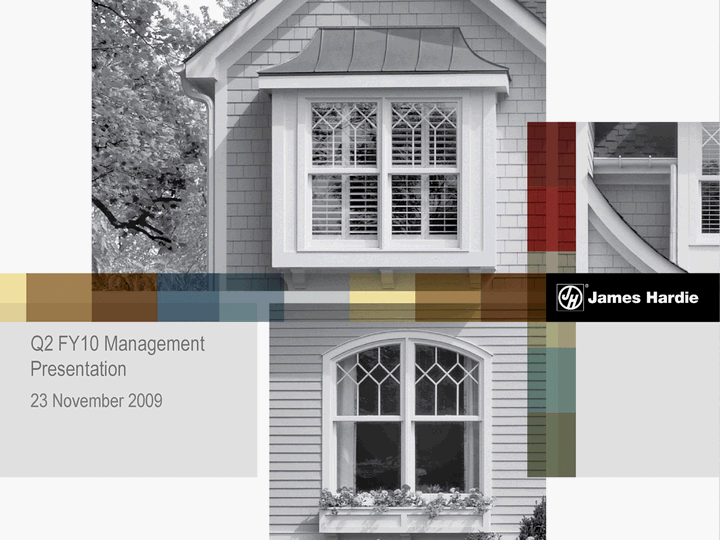
| Q2 FY10 Management Presentation 23 November 2009 |